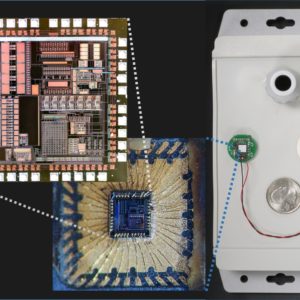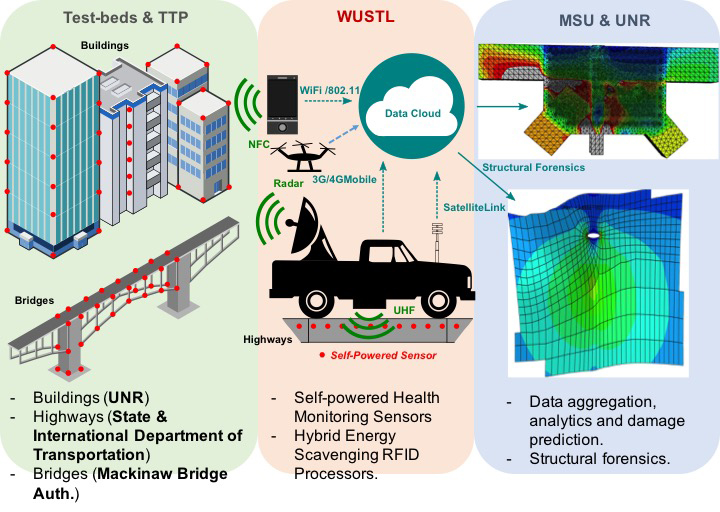https://www.youtube.com/watch?v=EnMp0OaAJRw
Our nation’s infrastructure includes massive networks of highways, roadways, bridges, ports, railways, energy delivery systems and aviation. Every American is reliant on these networks, yet they need an enormous amount of upkeep. Failure to maintain infrastructure has a wide range of ramifications, from economics to safety concerns.
A team of engineers from Washington University in St. Louis is turning to cloud computing for a smarter, self-monitoring solution that can better sound the alarm in specific cases of infrastructure failure. The concept will get its first test this week when it is installed Sept. 21 on Michigan’s Mackinac Bridge, the largest suspension bridge in the western hemisphere.
“Right now, the maintenance of infrastructure has an enormous cost,” said Shantanu Chakrabartty, professor of electrical & systems engineering at the School of Engineering & Applied Science. “It’s hard to know how to prioritize. So if you have data, you can do condition-based maintenance. Depending on which part of a structure is vulnerable, you can assign manpower according to that.”
The National Science Foundation (NSF) has awarded Chakrabartty’s team a 4-year, $1.1 million grant to develop long-term monitoring of our country’s infrastructure. The goal: creating smart civil infrastructure that can self-monitor, enabling it to predict any failures in case of an extreme event such as an earthquake or flood, and also prioritize areas for emergency response.
Grant collaborators include Nizar Lajnef from Michigan State University, and Gokhan Peckan from the Network of Earthquake Engineering Simulation at the University of Nevada-Reno.
Using support from the U.S. Department of Transportation, the Federal Highway Administration and the NSF, Chakrabartty’s team at Washington University had previously designed new sensors able to self-generate power from the minuscule movements, such as vibration or strain value, thus eliminating the need for a traditional battery.

The sensors can potentially be produced at such a low-cost that large numbers of these devices can be embedded into concrete used to construct roads, bridges and buildings. The new NSF grant will fund the construction of a virtual cloud-based structure for the sensors, allowing them to interface with a wireless network so that their information can be accessed quickly and efficiently in case of an emergency such as an earthquake, flood or even terror attack. The new network is expected to support and enhance maintenance efforts already underway.
“These sensors are going to continuously monitor the health of the structure, and if something goes wrong, then it’s going to report that to the cloud,” Chakrabartty said. “You never lose the data. So if something happens, you can go back and see that a certain part of the structure experienced abnormal levels of strain, and then according to that, you can schedule your emergency response and your maintenance.”
Washington University engineers are leaders in the field of infrastructure sensing via wireless technology. Chenyang Lu, professor of computer Science & engineering, has also developed cyber-physical simulators utilized to monitor the physical dynamics of civil infrastructure.
As for Chakrabartty’s research, it will soon move out of the lab and into its first-ever practical application. On Wednesday, Sept. 21, his team will help install the first sensors on the Mackinac Bridge, which connects the state’s upper and lower peninsulas. The suspension bridge, the fifth longest in the world, is widely regarded as a transportation icon, and provides a high-profile test site.
“There is huge potential and benefit for sensors like these on structures beyond the Mackinac Bridge, and we’re excited these prototypes are being tested here,” said Bob Sweeney, executive secretary of the Mackinac Bridge Authority. “We meticulously maintain and inspect the bridge each year, and sensors like these will complement our efforts, giving us even more information on the bridge’s condition to help keep it well-maintained and safe for many years to come.”
It is hoped that the Mackinac baseline test will allow the system to be further refined, and will eventually lead to widespread implementation.
“The technology we’ve developed, we can deploy it all over,” said Xuan Silvia Zhang, assistant professor of electrical & systems engineering and a member on Chakrabartty’s team. “We are truly making an impact to make people’s lives safer.”
Chakrabartty is available for interviews and may be reached at shantanu@wustl.edu
